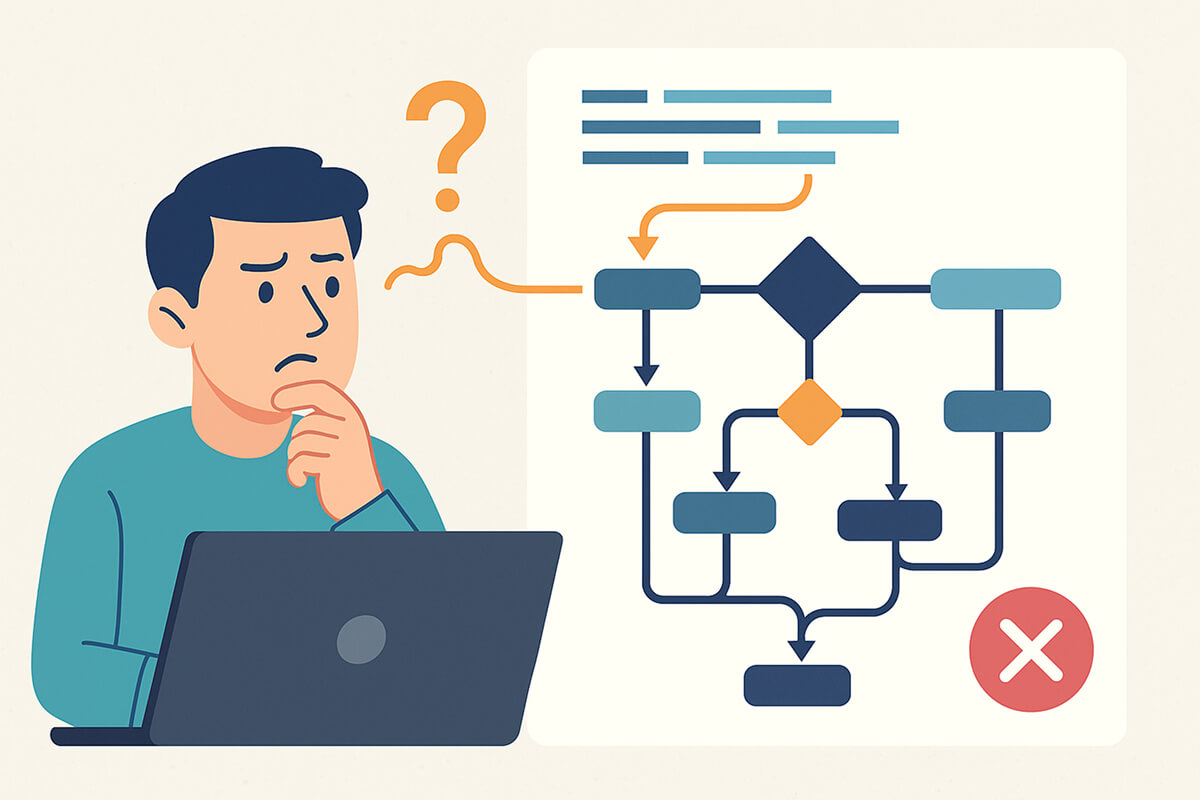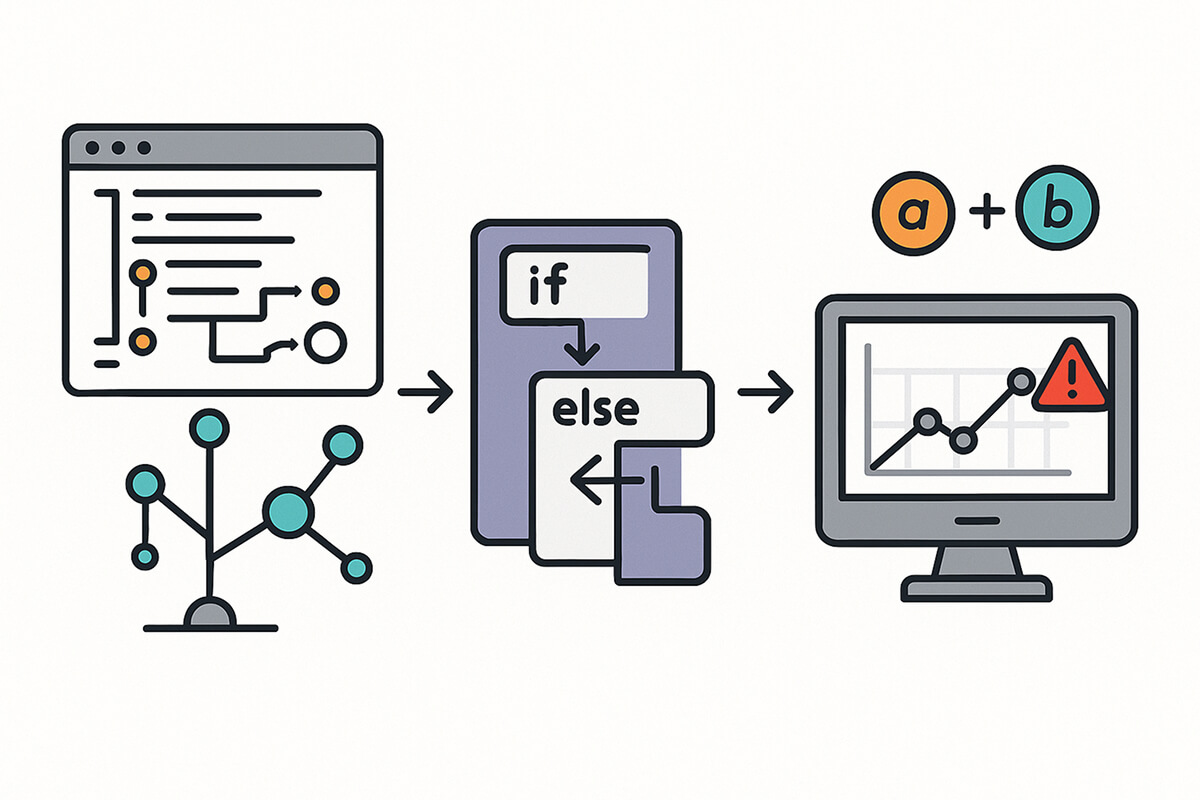Modern software evolves rapidly with new feature additions, quick fixes, and urgent patches. Over time, the codebase becomes harder to read, test, and extend. Code complexity metrics turn that growing cognitive load into objective numbers that the whole organization can track.
Ignoring code complexity is expensive: 40 % of global organizations report that poor software quality costs them $1M+ per year. Teams that watch these metrics and refactor early keep delivery fast and budgets under control.
What Is Code Complexity?
Code complexity refers to the additional effort required to comprehend what a program is doing and feel confident in making changes. Code complexity grows when a function branches in many directions or calls hidden helpers. Each additional path forces a developer to think, “What happens if…?” before making a change. The more choices and side effects, the more likely it is that someone overlooks an edge case and ships a defect.

Here’s a quick example to show why nested conditions slow you down:
def grant_discount(order, user):
if user.is_admin:
return True
if order.total > 100:
if user.has_coupon:
if order.items_in_stock():
return True
else:
return False
elif order.is_holiday and not user.is_first_time:
return True
return FalseAlthough it looks straightforward, it has multiple nested if blocks and conditions (is_admin, is_holiday, has_coupon, items_in_stock), making it difficult for a developer to make even a small change.
Sonar’s 2024-25 review of 7.9 billion lines of code found about 53,000 maintainability issues per million lines, or roughly 72 “code smells” per developer every month. Each one is a future defect or slowdown waiting to happen.
Reasons for High Code Complexity
- Feature creep: New requirements often get bolted onto old functions instead of being refactored.
- Tight timelines: If a critical bug occurs hours before a release, developers often release quick fixes like nested conditionals. Although these may resolve the issue for the day, continuous patches can turn the code into a mess.
- Inconsistent style: Different teams choose different naming rules and design patterns. Every style switch forces the reader to pause and re‑parse the logic.
- Lack of refactoring time: Without scheduled hardening sprints, small hacks accumulate into big, risky issues.
- Legacy integrations: Old APIs require defensive checks and workarounds.
- Over‑engineering: Premature abstractions add layers that solve problems the team never actually has.
What Are Code Complexity Metrics?
Software complexity metrics quantify how much effort it takes to understand and safely modify code. Higher numbers usually map to more defects, longer reviews, and slower releases. Common examples include:
- Cyclomatic complexity: Counts the number of independent execution paths.
- Cognitive complexity: Weighs nested logic and indirection to approximate human comprehension effort.
- Halstead metrics: Analyze operators and operands to estimate implementation “volume.”
- Lines of code (LOC): Raw count of executable lines.
- Maintainability index: Combines cyclomatic complexity, Halstead, and LOC into a 0-100 score (higher is better).
- Coupling between objects (CBO): Counts how many other classes a class touches.
How to Measure Code Complexity

Most static-analysis tool (like SonarQube or Codacy) turns raw source code into the complexity numbers you see on a dashboard using three simple steps.
Step 1: Parse and map the code
- The tool first “reads” every file the way a compiler does.
- It builds an abstract syntax tree (AST)-a structured outline that shows each statement, expression, and block.
- It also builds a control-flow graph, which traces every possible route the program can follow when it runs (loops, ifs, switches, and so on).
Step 2: Count the structural signals
- Walking through that map, the tool starts counting things that researchers found related to maintenance trouble
- How many decision points (if, else, for, while, case)?
- How deep is the nesting (an if inside a for inside another if)?
- How many unique operators and operands (used for Halstead metrics)?
Step 3: Emit the scores
- Finally, it calculates a number for each file, class, or function and pushes those numbers to your dashboard.
- Anything over your defined threshold limits turns the quality gate red.
Turning Complexity Data into Business Impact
Code complexity affects much more than simply code readability. It also impacts:
- How fast a project can be developed.
- How much testing effort is needed.
- How many bugs are likely to be present.
- How much maintenance will be required in the future.
Complexity metrics help you monitor these risks and make educated decisions before they affect delivery.
Complexity Slows Down Teams
Understanding a growing codebase becomes increasingly difficult for developers over time. Understanding deeply nested or scattered logic takes time. This makes even small changes time-consuming to implement. This can lead to slowdowns:
- New hires need longer to build a mental model before they ship their first PR.
- Reviewers must trace more paths, so feedback cycles stretch.
- Root‑cause analysis widens as logic hops across files and services.
- Test suites run longer, and regression risk climbs, so go-live dates slip.
Why This Leads to Higher Costs

Every delay in development or QA increases the cost of delivering a feature. Defects in complex areas are also harder to detect and more expensive to fix, especially when discovered in production. Over time, this can lead to these issues:
- Missed deadlines delay revenue or user adoption.
- Long pipelines consume more compute and developer wait time.
- Production issues in complex areas take longer to debug and fix.
- Teams spend sprint capacity fighting bugs instead of adding value.
How Complexity Metrics Help
Code complexity can seem vague. But numbers make it clear. Instead of guessing which parts of the code are “messy,” you can check scores and understand how hard the code is to read and change.
Here are three commonly used metrics and how they help:
1. Cyclomatic Complexity
Counts the different paths the code can take. A simple function has 1 or 2 paths. Each if, else, switch, or loop adds another path. When the count exceeds 10, you need more tests, and the code becomes harder to follow. Mark these functions for cleanup.
2. Cognitive Complexity
Shows the amount of mental effort required by the code. It adds points for deep nesting, recursion, and method calls. Even a small but tangled function can still score high. A high score warns that developers will find the code hard to follow.
3. Maintainability Index
This is a composite score (from 0 to 100) that combines cyclomatic complexity, lines of code, and Halstead metrics. A higher score means better maintainability. Anything below 20-30 signals that the file will need attention soon.
Using Metrics Effectively
The goal of tracking code complexity isn’t to get every score to zero. Some parts of your code will naturally be more complex. The goal is to keep scores in a safe range, so they don’t slow the team or create problems later.
1. Find Problem Areas Early
Review the updated complexity scores after each commit or pull request. If a file’s score climbs much higher than before, examine the recent change to see why the logic became harder to follow. Resolving the issue promptly is simpler than dealing with hidden problems that can turn into bugs or delays.
2. Focus Refactoring on What Matters
Give priority to files that both change frequently and have high complexity scores. Improving these hotspots removes obstacles that developers face every day and provides the largest return on the time you invest.
3. Track Code Health Over Time
A dashboard that shows complexity scores week by week gives leads and managers a clear picture of code health. If scores drift upward across several sections of the codebase, schedule cleanup tasks before the trend becomes a larger problem. If scores remain steady or improve, the current development practices are working well.
4. Make Code Reviews Smarter
Integrate tools such as SonarQube, Codacy, or ESLint into the pull‑request workflow so that complexity scores appear in the diff view. When a change pushes a score above the agreed limit, reviewers can ask the author to split functions, remove deep nesting, or simplify the logic before approving the merge.

You don’t have to check complexity by hand. Some tools do this automatically:
- SonarQube: Gives scores and flags risky code
- Codacy: Tracks code quality and shows trends
- Code Climate: Highlights problem areas over time
- ESLint plugins Add checks for JavaScript or TypeScript
Conclusion
Code complexity metrics help you see which parts of your code are hard to understand, test, or change. They turn hidden problems into clear numbers your team can track.
By using these metrics, you can spot issues early, fix the most important parts first, and keep your codebase easy to work with. This means faster development, fewer bugs, and lower long-term costs.
Understanding these metrics doesn’t just help developers; it also helps teams plan better, deliver faster, and manage projects more effectively.

